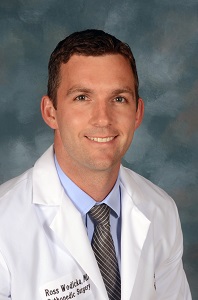Holy Cross Orthopedic Institute surgeon uses stemless anatomic procedure
April 5, 2023- Seventy-four-year-old chemist Gary Gold discovered ice hockey at the age of 18 and also played football in junior college. Years of contact sports led to multiple shoulder dislocations. Due to an unrelated injury, he had to hang up his skates long ago, but he and his wife remain active by walking up to 40 miles per month near their home in Pompano Beach.
By 28, x-rays showed Gold had developed bursitis in both shoulders at a very premature age. He chose to tough it out for decades and live with the pain.

Ross Wodicka, M.D
“I didn’t mind the pain,” Gold said, until it was too excruciating to handle during a road trip about five years ago. “I could not hold my right arm up. I still didn’t go to the doctor. That hurt so bad. I couldn’t sleep. I didn’t know how to make myself comfortable. It was murder, but I didn’t care. I’ve been smashed so many times, hurt so many times in my life.”
Gold could hear and feel his shoulders snap and pop when he’d reach to change the station on the stereo or raise a glass to his mouth, for example. Over time, arthritis set in and worsened in both shoulders. He made an appointment to get evaluated by orthopedic surgeon Ross Wodicka, M.D. at Holy Cross Health in Fort Lauderdale. Gold’s wife had previously been a patient of Dr. Wodicka’s.
Dr. Wodicka determined that Gold had worn down the cartilage in his shoulder joints, so it was bone-on-bone, and he was a candidate for a stemless shoulder replacement.
“It’s a bone-preserving type of shoulder replacement that allows active people like Gary to get back to things a little bit earlier,” Dr. Wodicka explained. “A standard, traditional shoulder replacement involves putting a stem or a long prosthesis into the bone and humerus.”
There are various types of shoulder replacements, depending on a patient’s specific condition. Gold had an anatomic shoulder replacement, “which means we’re basically replacing the ball with a ball and a socket with a socket,” Dr. Wodicka explained. “It relies on an intact or functioning rotator cuff.”
Dr. Wodicka doesn’t expect Gold to need any additional shoulder surgeries. Unless a patient falls or fractures the prosthesis, he estimates an anatomic shoulder should last 30 years.
If the rotator cuff wears out over time after the operation, the patient may need to eventually undergo a reverse shoulder replacement. Dr. Wodicka said he performs more reverse shoulder replacements because many patients “who have arthritis in their shoulder also have poorly functioning rotator cuffs based on age and activity.”
If all goes smoothly in the operating room, a stemless shoulder replacement only takes about an hour to complete. Patients are typically discharged the same day.
“We started sending people home outpatient once Covid started and we realized, based on a lot of data we collected, that people actually did better when they went home,” Dr. Wodicka said.
It’s become, in my practice, that about 90% of shoulder replacements go home the same day as an outpatient.”
Dr. Wodicka has performed more than 500 stemless shoulder replacements since Holy Cross Health began offering the procedure four years ago, which is when this new and revolutionary procedure hit the mainstream market. Holy Cross also participated in clinical trials.
Just like with any surgery, shoulder replacements can present complications. Dr. Wodicka said they take “extreme precautions” to prevent infections by prescribing patients antibiotics pre- and post-op and maintaining a sterile operating room. He added that a nickel-free prosthetic is available for patients who have a known nickel allergy to prevent an adverse reaction to the implant.
Had Gold sought a corrective procedure in his 20s or 30s when he first began experiencing pain, a replacement would likely not have been an option yet. Dr. Wodicka said he probably would have been treated with injections back then.
“The beauty of medicine and scientific advancement is probably 10 years from now, we’ll be looking at what we did today as archaic, but that’s how things evolve,” Dr. Wodicka said.
Knee and hip replacements remain more common than shoulder replacements, but Dr. Wodicka said approximately 70,000 shoulder replacement surgeries were performed in the United States last year and “that number is actually growing much faster than hip and knee replacements because it’s a newer operation.”
Gold’s two shoulder surgeries were scheduled 17 weeks apart to allow him time to rehab the first shoulder before undergoing the second procedure. Dr. Wodicka advises patients to wear a sling for 4 to 6 weeks post-op and to remain committed to physical therapy. If people follow through with the PT he prescribes, most patients return to most activities at the three-month mark and have a full recovery by six months.
Gold went to physical therapy at Holy Cross and gives credit to his trainer for helping him regain his range of motion. He can now flap his arms and reach around to wash and scratch his back. He joked that when he viewed his x-rays, he looks like a “mechanical man.”
“I can do way more than I could do for 30 or 40 years,” Gold said. “My arms and shoulders feel way better then when I was in my 20s. Guaranteed. I’ll say that 100%, the most important thing after surgery is physical therapy. That’s what I harp on.”
Even though Gold has seen great strides in the advancement of shoulder pads to offer better protection, Dr. Wodicka still sees a lot of hockey players of all ages in his office. Despite the warm climate of South Florida, ice hockey is a very popular sport here. Football, other contact sports and power lifting are also culprits behind shoulder injuries.
“Once [you dislocate your shoulder the first time], it increases your chance of it happening again by tenfold, so every time you dislocate your shoulder, it makes your shoulder more unstable and you can dislocate it again,” Dr. Wodicka said.
Dr. Wodicka created a handout with a shoulder conditioning program he recommends athletes follow at least three times per week to preserve their shoulders long-term. He guides people through lifting weights appropriately to protect the rotator cuff, the group of muscles and tendons that rotate the shoulder and lift the arm.
If you are experiencing persistent shoulder pain, a popping sensation, weakness or difficulty lifting your arm or feel like your shoulder is unstable, Dr. Wodicka suggests consulting with an orthopedist. To schedule an appointment with Dr. Wodicka, call the Holy Cross Orthopedic Institute at (954) 542-4160. For more information, visit rosswodickamd.com.



























